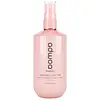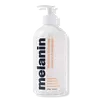What's inside
What's inside
 Key Ingredients
Key Ingredients

 Benefits
Benefits

 Concerns
Concerns

 Ingredients Side-by-side
Ingredients Side-by-side

Quaternium-91
Behentrimonium Chloride
PreservativeMyristyl Myristate
EmollientCetearyl Alcohol
EmollientAloe Barbadensis Leaf Juice
Skin ConditioningCetrimonium Chloride
AntimicrobialDiheptyl Succinate
EmollientCapryloyl Glycerin/Sebacic Acid Copolymer
Skin ConditioningSimmondsia Chinensis Seed Oil
EmollientPersea Gratissima Oil
Skin ConditioningOlea Europaea Fruit Oil
MaskingArgania Spinosa Kernel Oil
EmollientFragaria Ananassa Seed Oil
AntioxidantRubus Idaeus Seed Oil
EmollientCitrullus Lanatus Seed Oil
EmollientDehydroacetic Acid
PreservativeBenzyl Alcohol
PerfumingParfum
MaskingPanthenol
Skin ConditioningHibiscus Sabdariffa Flower Powder
AbrasiveQuaternium-91, Behentrimonium Chloride, Myristyl Myristate, Cetearyl Alcohol, Aloe Barbadensis Leaf Juice, Cetrimonium Chloride, Diheptyl Succinate, Capryloyl Glycerin/Sebacic Acid Copolymer, Simmondsia Chinensis Seed Oil, Persea Gratissima Oil, Olea Europaea Fruit Oil, Argania Spinosa Kernel Oil, Fragaria Ananassa Seed Oil, Rubus Idaeus Seed Oil, Citrullus Lanatus Seed Oil, Dehydroacetic Acid, Benzyl Alcohol, Parfum, Panthenol, Hibiscus Sabdariffa Flower Powder
Water
Skin ConditioningDiheptyl Succinate
EmollientCapryloyl Glycerin/Sebacic Acid Copolymer
Skin ConditioningBehentrimonium Methosulfate
Glycerin
HumectantCetearyl Alcohol
EmollientPanthenol
Skin ConditioningAloe Barbadensis Leaf Juice
Skin ConditioningSimmondsia Chinensis Seed Oil
EmollientArgania Spinosa Kernel Oil
EmollientWheat Amino Acids
Skin ConditioningHydrolyzed Wheat Protein
Skin ConditioningBrassica Rapa Root Extract
Skin ConditioningCamellia Sinensis Leaf Extract
AntimicrobialChamomilla Recutita Flower Extract
MaskingHumulus Lupulus Extract
AntimicrobialRosmarinus Officinalis Leaf Extract
AntimicrobialHydrolyzed Adansonia Digitata Seed Extract
Bambusa Vulgaris Extract
Skin ConditioningMentha Viridis Leaf Oil
AstringentCaprylhydroxamic Acid
Caprylyl Glycol
EmollientCitric Acid
BufferingWater, Diheptyl Succinate, Capryloyl Glycerin/Sebacic Acid Copolymer, Behentrimonium Methosulfate, Glycerin, Cetearyl Alcohol, Panthenol, Aloe Barbadensis Leaf Juice, Simmondsia Chinensis Seed Oil, Argania Spinosa Kernel Oil, Wheat Amino Acids, Hydrolyzed Wheat Protein, Brassica Rapa Root Extract, Camellia Sinensis Leaf Extract, Chamomilla Recutita Flower Extract, Humulus Lupulus Extract, Rosmarinus Officinalis Leaf Extract, Hydrolyzed Adansonia Digitata Seed Extract, Bambusa Vulgaris Extract, Mentha Viridis Leaf Oil, Caprylhydroxamic Acid, Caprylyl Glycol, Citric Acid
 Reviews
Reviews

Ingredients Explained
These ingredients are found in both products.
Ingredients higher up in an ingredient list are typically present in a larger amount.
Aloe Barbadensis Leaf Juice comes from leaves of the aloe plant. Aloe Barbadensis Leaf Juice is best known for helping to soothe sunburns. It is also anti-inflammatory, moisturizing, antiseptic, and can help heal wounds.
Aloe is packed with good stuff including Vitamins A, C, and E. These vitamins are antioxidants, which help fight free-radicals and the damage they may cause. Free-radicals are molecules that may damage your skin cells, such as pollution.
Aloe Barbadensis Leaf Juice also contains sugars. These sugars come in the form of monosaccharides and polysaccharides, folic acid, and choline. These sugars are able to help bind moisture to skin.
It also contains minerals such as calcium, 12 anthraquinones, fatty acids, amino acids, and Vitamin B12.
Learn more about Aloe Barbadensis Leaf JuiceYou may know this ingredient as argan oil. Argan Oil has antioxidant, hydrating, and soothing properties.
Studies have shown argan oil can help fight again radical damage from the sun. This makes it effective at preventing hyperpigmentation.
Large amounts of vitamin E found in argan oil helps the skin retain water. Argan oil also contains fatty acids such as linoleic acid, oleic acid, and palmitic acid. It is also a good source of lipids.
Another benefit of argan oil is skin-soothing. It can help reduce inflammation-related skin symptoms.
Argan Oil is effective at regulating sebum production in pores. This can make it effective at treating hormonal acne.
Traditionally, argan oil was used for its antibacterial and antifungal properties. However, argan oil contains fatty acids that may make it not fungal-acne safe.
Argan Trees are native to Morocco.
Learn more about Argania Spinosa Kernel OilWe don't have a description for Capryloyl Glycerin/Sebacic Acid Copolymer yet.
Cetearyl alcohol is a mixture of two fatty alcohols: cetyl alcohol and stearyl alcohol. It is mainly used as an emulsifier. Emulsifiers help prevent the separation of oils and products. Due to its composition, it can also be used to thicken a product or help create foam.
Cetearyl alcohol is an emollient. Emollients help soothe and hydrate the skin by trapping moisture.
Studies show Cetearyl alcohol is non-toxic and non-irritating. The FDA allows products labeled "alcohol-free" to have fatty alcohols.
This ingredient is usually derived from plant oils such as palm, vegetable, or coconut oils. There is debate on whether this ingredient will cause acne.
Due to the fatty acid base, this ingredient may not be Malassezia folliculitis safe.
Learn more about Cetearyl AlcoholWe don't have a description for Diheptyl Succinate yet.
Panthenol is a common ingredient that helps hydrate and soothe the skin. It is found naturally in our skin and hair.
There are two forms of panthenol: D and L.
D-panthenol is also known as dexpanthenol. Most cosmetics use dexpanthenol or a mixture of D and L-panthenol.
Panthenol is famous due to its ability to go deeper into the skin's layers. Using this ingredient has numerous pros (and no cons):
Like hyaluronic acid, panthenol is a humectant. Humectants are able to bind and hold large amounts of water to keep skin hydrated.
This ingredient works well for wound healing. It works by increasing tissue in the wound and helps close open wounds.
Once oxidized, panthenol converts to pantothenic acid. Panthothenic acid is found in all living cells.
This ingredient is also referred to as pro-vitamin B5.
Learn more about PanthenolThis oil comes from the seeds of the desert shrub called Jojoba. It is more commonly known as jojoba oil, a non-comedogenic oil.
Jojoba oil does not contain fragrance and has many fatty-acids, making it a great soothing ingredient.
It also contains Vitamin E, a great moisturizing ingredient. Vitamin E is also an antioxidant and protects your skin against oxidative damage.
This ingredient humectant properties, meaning it helps draw moisture from the air. This helps keep your skin hydrated.
While jojoba has antibacterial properties, it is only able to kill some strains of bacteria.
Studies also show it helps in wound healing. In fact, Indigenous cultures have used jojoba as a moisturizer and to help treat burns for centuries.
Fun fact: Jojoba oil similar to natural human skin sebum, so it has a great effect on dry skin. It is also promising with helping to regulate sebum production.
Due to its fatty acid content, Jojoba oil may not be fungal acne safe. We recommend speaking with a professional if you have any concerns.
Learn more about Simmondsia Chinensis Seed Oil